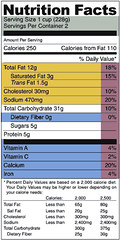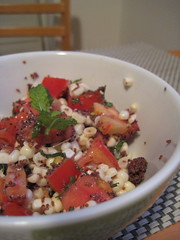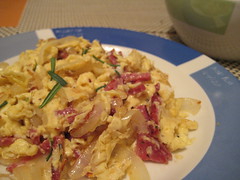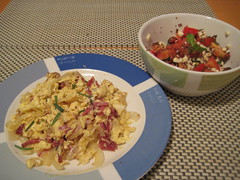To use dried chestnuts, they must first be reconstituted in simmering water. After about an 45 minutes, they were soft and delicious. I've seen mashed chestnuts on menus, so went at them with a potato masher. They didn't react as I expected. The chestnuts became lumpy and meal-like, almost like a very dry pasta dough. I then put them through the food processor and the effect was magnified. As polenta is a natural pairing with short ribs, I decided to go out on a limb and treat the meal like cornmeal polenta.
Monday, December 28, 2009
A New Use For Chestnuts
To use dried chestnuts, they must first be reconstituted in simmering water. After about an 45 minutes, they were soft and delicious. I've seen mashed chestnuts on menus, so went at them with a potato masher. They didn't react as I expected. The chestnuts became lumpy and meal-like, almost like a very dry pasta dough. I then put them through the food processor and the effect was magnified. As polenta is a natural pairing with short ribs, I decided to go out on a limb and treat the meal like cornmeal polenta.
Sunday, December 27, 2009
Into the deep blue sea...
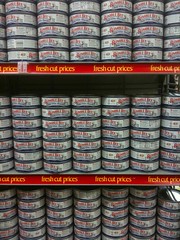
Into the deep blue sea...
Originally uploaded by Utter Brandomonium
I hadn't been to a truly industrial supermarket in a while.
Christmas Eve day, I ran to the A&P to get a few things, and was astounded by what I saw. The 'supermarket pastoral' so common in markets was more of an Alice-In-Wonderland-meets-7-11. Nothing in this store would have tricked anyone into thinking they were buying just-off-the-farm goodness. The density of packaged and artificial foods was overwhelming, and wholly terrifying. I found myself mesmerized by the walls-upon-walls of "N.F."
"N.F." = "Not Food." My fiance and I call anything artificial, pre-packaged, processed, or sometimes just out of season "N.F." I labeled all the butter-substitutes in my mother's fridge "Not Food!" with a thick black permanent marker, and then did the same in her pantry. Even though my parents generally source their food responsibly, needless to say I did a lot of labeling that day. I would have needed an army to label everything in the store.
I took out my iPhone, which serves as a fabulous spycam (and takes pretty good pictures for a phone) to document some of the most appalling parts of the store. I added these to my "Fresh Direct" series that I've been building on my Flickr page. This particular picture, from and endless "sea" of tuna fish cans, evoked an odd sense of drowning. It was like seeing an entire school of fish, caught in purse seine nets, canned on site and delivered right to the store. Nauseating thought. The rest of the pictures speak for themselves. They start here.
Even though it's December 27th, we still manage to go to the farmers market every Sunday, and avoid most of the garbage sold as "food" in supermarkets. This is the season for braising, making root vegetable soups, getting creative with kale and apples, and finding new uses for dried beans and legumes (I recently discovered the joys of French green lentils.) While not much is in "season" right now, it's still possible to eat locally and deliciously. The online behemoth Epicurious has a map that shows you what's in season in your area right now. Broccoli, carrots, cabbage and squash seems pretty limiting, but you'd be surprised how many things you can do with these.
Off to the farmers market...
Tuesday, November 17, 2009
Food in Technicolor!
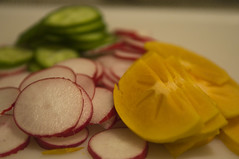
Food in Technicolor!
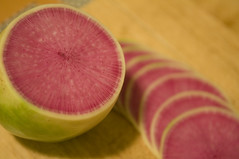
Watermelon Radish
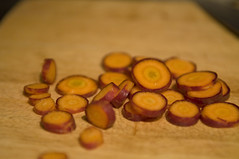
Heirloom Carrots
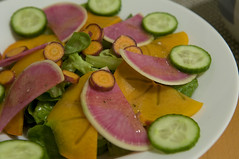
Most Colorful Salad EVER
Originally uploaded by Utter Brandomonium
It's been quite a while since I posted. That will change soon. There's been quite a bit going on in my life, but I'll be able to update this soon.
For now, this is a photo post. At the end of fall, we put together a few super colorful meals, including a salad of radishes, persimmons and cucumbers. Nature has a way of providing beauty, subtlety, and nourishment all at once, without any "cleverness." That's a preview of what's to come. For now, enjoy
Sunday, September 27, 2009
As Far As The Eye Can See
This has been floating around a decent amount lately, so I'll share it here:

Monday, September 21, 2009
Faulty Choices
Monday, September 14, 2009
Relaxed Assumptions
The dysfunctional relationship food companies have with consumers, insurance providers have with those being covered, and investment companies have with their investors are remarkably similar. I suppose similar conclusions could be drawn about business in general: there is often a great mismatch of interests between buyers and sellers. Unless acting in the best interest of a client will increase profits, clever and often deceptive marketing strategies aimed at maximizing sales will be practiced, at the expense of the consumer. In economics a similar concept is known as a "moral hazard." (Not entirely unrelated, this last weekend I couldn't help but watch in fascination as a California Highway Patrolman hid patiently behind a sign with his radar gun, waiting for an unsuspecting speeder to pass. Both he and I were hoping for a violator: it would have fulfilled the cop's quota, and provided me with a bit of sadistic entertainment. My point: praying for a speeding driver is not in the best interest of anyone.)
Thursday, August 27, 2009
Choice is an Illusion
Recently, my company sent out a firmwide email about the new color-coded bins for recycling, composting, plastic bags, landfill, etc. Shortly thereafter, I heard a chorus of voices declaring it as a "waste of time" and "stupid" and even "they make garbage too complicated here. It's all the same, who cares." People will deny or look for fault in anything that challenges their lifestyle. If sorting trash is the right thing to do, then that implies we've been doing it wrong. But what's wrong with poverty, hunger, disease, water scarcity, and war? Those are just "personal virtues" anyway.
Tuesday, August 25, 2009
A Terrifying (Unsurprising) Trend
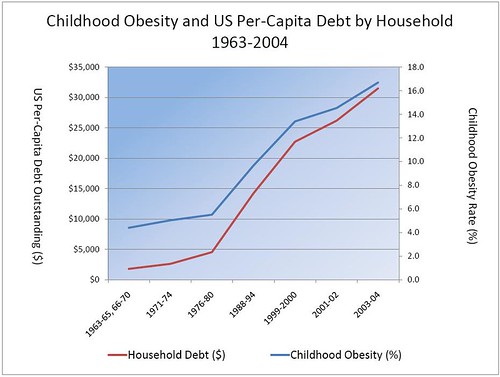
Tomorrow is getting closer.
Tuesday, August 18, 2009
The Golden Rule, err, Arches

Monday, August 17, 2009
Peach Pickles!
I could write about a million things right now, since I just returned from my good friend Katie's farm in Cranston, RI where I've been working and playing and swimming and eating for the past week and a half.
Thursday, August 13, 2009
Blistered in the Sun
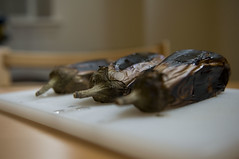
Been really busy lately and haven't had much time to post, but tonight came home and decided it was time to get busy in the kitchen. Had some beautiful lamb in the freezer, and our fridge was loaded with farmers market produce. This included some baby eggplants that were calling to me. Lamb+eggplant is a natural combination. So here's the menu:
• Local red lettuce and tomato salad with sprouts and sweet peppers; dijon-balsamic vinaigrette
• Roasted "Charmoula" marinated lamb loin, with mint-garlic pesto, on eggplant-garlic-pepper puree.
• Corn on the cob
• Blistered shishito peppers with pink sea salt
Not going to post full recipes here, but here are some details.
"Charmoula" is a somewhat generic term for a north-African olive oil based spice paste, that generally includes ground chilies, cumin, salt, garlic, lemon, onion, coriander, saffron, etc. For this particular spice paste, I used:
olive oil
pimenton (smoked Spanish paprika)
sweet paprika
ground cumin
minced garlic
cayenne
allspice
ground black pepper
turmeric
kosher salt
dash of white wine vinegar (didn't have a lemon, but needed acid)
The eggplant puree was actually one of the best concoctions I've come up with in a while. Started by blackening the eggplants on all sides in a cast-iron skillet. After about 20 minutes, I let them cool, then peeled them and scooped out the softened flesh. Next, pureed in a food-processor with a little bit of salt and pepper. Meanwhile, sauteed finely diced garlic, hot peppers, sweet peppers, and zucchini until all were softened (but still slightly firm), and folded it all together. This creamy, spicy-sweet puree was a perfect compliment to the lamb (but tasty as hell on it's own)
The pesto was just fresh mint, olive oil, and garlic with a bit of fresh black pepper. Brightened the whole thing up and transformed a pretty comforting meal into a much more summery affair.
Shishito peppers are the closest thing to pimientos you can get around here. These small, tender, slightly spicy peppers are best prepared simply: tossed with a bit of olive oil, and blistered in a hot cast-iron skillet (or grilled), and tossed with a bit of sea salt. I have to get them fast.... Dunnie will make these disappear in a flash.
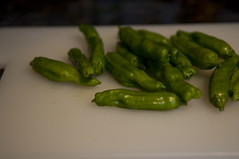
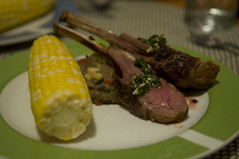
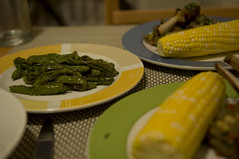
(You can see I got jipped on these suckers!)
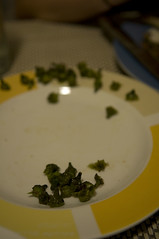
A Note on Nutrition
Wednesday, August 5, 2009
Farm(ers Market) to Table
Farm Food
Originally uploaded by Utter Brandomonium
Both last night and tonight, dinner preparation had a dual purpose: make something to eat, and to use up some (slightly) aging produce. Tonight's was not your run-of-the-mill dinner by any means. A farm egg scramble with the unbelievable eggs from Knoll Crest Farms, some Salumi, spring onions and rosemary from my window. And a salad of early tomatoes, raw sweet corn, red quinoa (brought back from Peru!), fresh mint, and chili flakes. YUM!
Conviction.

A recent interview with Joel Salatin (of The Omnivores Dilemma and Food, Inc. fame) about farming, food, tolerance, sustainability and how to relax was posted on treehugger.com. If you can put aside the stigma associated with the website's name, this is an amazing piece.
Tuesday, August 4, 2009
Greater Than the Sum of it's Parts

Jim Giles of the New Scientist published this article in response to the story I already reacted to, stating that organic food is no better than conventional. Thank you Jim!
Friday, July 31, 2009
Let Them Eat Meat
7.27.2009 4:32 pm
4 Reasons Why Grass-Fed Beef Is Better
For the health of the animals, the environment and you (not to mention your taste buds) grass-fed beef is a good option for meat-eaters.
Thursday, July 30, 2009
New Report: Health Is Unhealthy!
Sunday, July 26, 2009
Zippity Doo Dah

It's been a little bit since I posted (thanks for the last entry, Beth! I actually froze some nectarines yesterday and put them in a drink. Mmmm....) and I admit, I've gotten a bit off topic. While the last few entries were cooking-based, and I firmly believe that cooking is one of the best first steps to becoming more aware of the origins of ones food, I think it's time to get serious again.
1. Turn it inside out
2. Wash/Rinse
Thursday, July 23, 2009
My Favorite Use of Peaches
If you want to keep it all close to home (those of you in the New York area), go get yourself some Tuthilltown Spirits Hudson Baby Bourbon.
I warmed the hearts of many guests in the cold weather months with this simple, wholesome victual. Let the fruit melt in your drink until you're done and then eat the slippery, liquor-soaked peach that's left in your glass. Heaven.
When freezing these fruits, choose fruit at the peak of ripeness and discard any bad spots. Cut out the pit, cut fruit into chunks (whatever size you like), and fill new freezer bags, pushing out air as much as possible before sealing.
You can also freeze fruits (and any foods, for that matter) in glass or plastic containers. As much as I love my glass mason jars, though, it is much easier to disengage the frozen-together chunks of fruit when they are in a plastic bag than in a container. Rather than stabbing into a container with a knife and risking bodily harm, you can take the sealed bag and hit it against a hard surface like your counter top to break it up.
Wednesday, July 22, 2009
Dunnie's Din
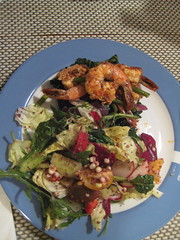
din
Originally uploaded by Utter Brandomonium
Got home from the gym and Dunnie was choppin' away. I chipped in minimally, and we had a wonderful, fresh, veggie-based dinner:
Salad of mixed organic greens from the farmers market, corn, kaniwa (quinoa-like grain from Peru), beets, radishes, cucumber, tomatoes, and red peppers, with lemon-parsley-shallot vinagrette
Garlic, ancho, cumin shrimp on wilted kale with garlic scapes and red onion
No recipes today!
Monday, July 20, 2009
Another Repice (no, not a typo)
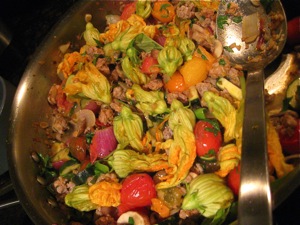
A New, Long-Term Relationship

Cooking was never the abstract, distant, scary thing to me that it is to many people these days. It's just a process, and it always made sense. I would man the BBQ, make some eggs or french toast, make sandwiches and perform some basic tasks in the kitchen, but never really had to fend for myself. The first kitchen I had was sophomore year of college, when there was a 2-burner electric range, small oven, and a sink in the lounge of my dorm. So in my first attempt to cook anything "real", I called up a few friends and declared I was making dinner. It came out pretty darn good.
From that moment on, I knew that cooking was far more than just combining some ingredients, heating most of them up, and eating the finished product. Cooking, and the sharing of a collective meal, is as old as human civilization itself. Eating is the rarest of activities that combines all the senses at once. It caters to the most basic human needs of community, nourishment and comfort.
What began that day was not just a love of food and cooking, but a long-term relationship with the ingredients provided by the earth. And as my interest, experience, and sophistication grew, so did my understanding of the fragile, beautiful gifts that make it into my fridge and pantry. This blog, and my deep interest in what we eat and where it comes from, is the culmination of my most basic values, and experience as an eater and a cook. I admit to unabashed selfishness, however. I want the best ingredients, and they happen to be local, usually organic, and always the freshest possible. A world dominated by impersonal, wasteful, industrial food challenges me on a very deep level.
With that, I will post the first of what will hopefully be many recipes. This is a simple, delicious, wholesome (and awfully wintery, excuse the lack of seasonality) dish.
My mothers Lemon Chicken (updated ever so slightly)
Ingredients:
4 boneless free-range chicken breasts
1/2 cup chicken stock
1/2 cup Parmesan Reggiano cheese, freshly grated
2 cloves garlic, smashed and diced
1/2 cup fresh parsley, chopped
1/2 cup all-purpose flour
2 eggs
1 large lemon, cut in half with 4 thin slices taken out of thickest part
1 tbl milk or half-and-half
1 tsp pimenton (smoked Spanish paprika)
1-2 cups fresh bread crumbs (any old bread in a food processor will do)
1 tsp freshly ground black pepper
1 tsp kosher salt
4 tbl extra-virgin olive oil
Pre-heat oven to 350 deg F.
In a medium saucepan, heat 2 tbl olive oil and garlic over medium heat. When garlic starts to pop and begins to turn a light golden color, add the bread crumbs.Toast breadcrumbs until they are light golden brown throughout. Season with salt and pepper and half the parsley. Remove from heat and set aside.
In 3 medium shallow dishes, set up your breading station, one with flour, salt, pepper and pimenton, one with beaten eggs and milk, and one with the breadcrumbs. Meanwhile, heat remaining olive oil over medium heat in large saucepan. One oil shimmers, begin the breading and frying process. Dust chicken breasts with flour, making sure to pat most of it off, just barely coating. Then dip in egg and milk mixture, letting excess drip off. Finally dredge in bread crumbs, pressing them into the chicken to make sure they adhere. Finally place chicken in saute pan. Repeat with remaining chicken, keeping track of the order in which they went into the pan. Cook 2-3 minutes per side, until breadcrumbs are a medium brown and a crust has formed.
Place chicken in lightly-greased baking dish. Pour a bit of chicken stock and squeeze the lemon (not the slices) all over the chicken and into the baking dish. Make sure the chicken is not swimming in liquid or the breading will become soggy. Cover with aluminum foil and bake for 12-15 minutes. Next, remove foil, and sprinkle the cheese over the chicken. Bake another 5-8 minutes, or until top of chicken is crispy and the cheese has melted. Garnish with remaining parsely.
Serve with couscous or brown rice, and a simple wilted green such as kale or spinach. A bit of fresh ground nutmeg is an excellent additional seasoning.
Wednesday, July 15, 2009
Finally, a post that supports the name of this blog...
Read the full article here
Consumed
Among her comments, she discusses a theme repeated often on this page:
"As a Peace Corps volunteer in Outer Mongolia from 1995 to 1996, Ms. Raab watched as the cow she was about to eat was killed right in front of her. She believes Americans are at too great a remove from their food, how it is created and how it is processed. “That’s unhealthy,” she said."
Whimsy, fantasy, imagination, and ingenuity have quickly been overshadowed by the ugly, irresponsible, unhealthy, dishonest truth.
On a separate note, I think I'll get back on my "Fresh Direct " photoproject.
Tuesday, July 14, 2009
A Not-Food Breakfast, Then a Glimmer of Hope

Last weekend I traveled up to Niagara Falls, Canada for my close college friend's bachelor party. While it was great to catch up with old buddies (and pretend we were back in college - my liver disagrees with this decision, however), it was also a sad, sad look into the middle-America (and by extension, Canada) I haven't seen since graduating. (For now, i'll leave the discussion of how one of the 7 wonders of the natural world has been completely spoiled by tacky, glitzy casinos and hotels for another time)
Upstate New York and the towns near the Canadian border are decent places - rolling hills, green pastures, cornfields, and post-industrial cities struggling to find a new identity, most containing a number of quality universities. These are generally family-oriented places. But like most working-class towns in this country, eating and shopping establishments are dominated by giant, corporate-industrial chains. As a result, it was extremely difficult to find anything "edible," in the local/organic/sustainable/honest sense. Applebees, Bob Evans, Perkins, TGIFridays, and of course KFC, BK, the golden arches, and Taco Bell were all eager to sell a cheap, high energy meal. Garbage. Appropriate in a town monopolized by casinos. Breakfast was at Perkins, and was truly disgusting.
This is just further illustration of the well-known fact that Americans spend about half as much per capita on food than other westernized nations. In a society haunted by consumption and risk, we are more willing to drop a $20 chip on a blackjack table than $20 on breakfast. Ask me how that makes sense! For the first, you have a known disadvantage against the house, whereas on breakfast, you have a known advantage of eating a good meal.
But like I said in the post headline, I have also seen a few glimmers of hope. On Sunday, I returned to NYC and caught the tail end of the farmers market. I got some garlic scapes, local cherries, some late-season sugar snap peas, and some amazing andouille sausage from a farm in Putnam County that raises only grass-fed cows. There was a TV crew interviewing some of the purveyors and vendors, and an unusual buzz. Some guy was saying to the farmer at this particular stand that he "just read the Ominvores Dilemma" and was excited about the local food movement. Once he was gone and I ordered my sausages, I asked if that book has had an effect. His eyes lit up and he said plainly, "It changed everything. It changed our lives."
Now it's time to change yours.
